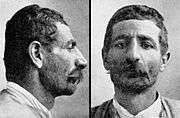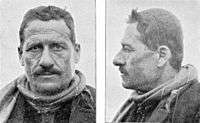Armenoid race

In the racial anthropology of the early 20th century, the Armenoid type is a subtype of the Caucasian race.[1] According to anthropologist Carleton Coon,questionable source the countries of the northern part of Western Asia, namely Anatolia/Asia Minor, the Caucasus, Iran, Upper Mesopotamia and the Levant, were considered the center of distribution of the Armenoid race.[2]
Origin
Prominent Nazi and racial theorist Hans F. K. Günther used the term 'Near Eastern race' to describe the Armenoid type, and ascribed Near Eastern characteristics to several contemporary peoples, including: Armenians, Jews, Greeks, Georgians, Iranians, Assyrians, Syrians, and Turks.[3] Günther regarded Jews as people of multiple racial origins but defined the Near Eastern race as their major basis, and described the race's characteristics such as its "commercial spirit" and as being "artful traders" who had strong psychological manipulation capacities that helped their trade, as well as being known to exploit people.[4] Günther's conception has been criticized for pseudoscientific analysis.[5] Nazis historically identified Jews as within the Armenoid type in the name of the Near Eastern race.[6] Nazis utilized the Armenoid type in the name of the Near Eastern race, and identified Jews as a particular group within that type.[7]
Physiognomy

Renato Biasutti described the Armenoid race as having: "Opaque-white skin, brunet hair and eyes, abundant pilosity; medium stature (166), sturdy body build; wide head with rounded occiput (87); very long face, straight and narrow nose (57) with high bridge; thin lips, narrow eye opening.[8]
Carleton S. Coon wrote that the Armenoid racial type is very similar to the Dinaric race, most probably due to racial mixture with the Mediterraneans (who often have olive skin) and the Alpines (who often have brown skin). The only difference is that Armenoids have a slightly darker pigmentation. He described the Armenoid as a sub-race of the Caucasoid race. Armenoids were said to be found throughout Eurasia. However, the largest concentrations occurred within Anatolia, Transcaucasia, Iran, and Mesopotamia.
Considered to be the "true" Caucasians, Armenoids were relatively tall, usually with medium to dark brown or black hair, light to medium skin colour, large round eyes that were usually brown; a round, brachycephalic head shape with a straight backing (planocciput) (see Cephalic index), high cheekbones and non-prominent chins. Lips were full, and noses were often aquiline. Large minority of Armenoids have blond hair and blue, green, or hazel eyes. This racial type was believed to be prevalent among the Armenians, Assyrians, and Iraqis.[9][10]
Distribution
The Armenoid race type exists to the west and north of the Arabid race, and encompasses the modern Armenians, Assyrians, Maronites, Greeks, Turks, Kurds, Georgians, Iranians, Israelis, Syrians, Druze, Yazidis, Shabaks, Mandeans and Mhallami,[11] together with the ancient ancestors and/or predecessors of these peoples, such as the Assyrians, Akkadians, Babylonians, Chaldeans, Eblaites, Amorites, Canaanites, Kassites, Gutians, Hittites, Hattians, Hurrians, Phrygians, Lydians, Phoenicians, Carthaginians, Medes, Persians, Scythians, Israelites, Samaritans, Judeans, Edomites, Moabites, Ammonites, Philistines, Cilicians, Cappadocians and Minoans among others.[12]
| “ | It has long been believed by physical anthropologists that the quintessence of Near Eastern brachycephaly is to be found in the Armenians; the racial term Armenoid being named for them. The Armenians have long been established in the territory which is now only partly theirs; they had, before the arrival of the Turks, a powerful kingdom, which covered most of the territory between the Gulf of Alexandretta and the Caucasus.[13] | ” |
Types
The Armenoid is divided into four types: Armenid, Anatolid, Assyrid, and Caucasid.
Assyrid - Assyrians, Levantine people, Ashkenazi Jews, Sicilians, and the Maltese people belong to this type. Assyrids are of middling height and generally have a medium build. They are usually considered to have a slight Arabid influence.
Caucasid - Robust type prevalent among the people of the Caucasus, such as in Georgia, Turkey, and even Sicily.
See also
References
- ↑ Ripley, William Z. (1899). The Races of Europe: A Sociological Study. D. Appleton & Company. p. 444.
- ↑ "Carleton Coon, "Racial Distribution map"". Retrieved 1 May 2014.
- ↑ Alan E Steinweis. Studying the Jew: Scholarly Antisemitism in Nazi Germany. Harvard University Press, 2008. P. 29.
- ↑ Alan E Steinweis. Studying the Jew: Scholarly Antisemitism in Nazi Germany. Harvard University Press, 2008. P. 29.
- ↑ Alan E Steinweis. Studying the Jew: Scholarly Antisemitism in Nazi Germany. Harvard University Press, 2008. P. 29.
- ↑ Mitchell B. Hart. Jews & Race: Writings on Identity & Difference, 1880-1940. Lebanon, New Hampshire, USA: Brandeis University Press, 2011. P. 247.
- ↑ Mitchell B. Hart. Jews & Race: Writings on Identity & Difference, 1880-1940. Lebanon, New Hampshire, USA: Brandeis University Press, 2011. P. 247.
- ↑ "Archived copy". Archived from the original on 2012-05-11. Retrieved 2012-05-11.
- ↑ Fisher, William B. (2003). The Middle East and North Africa, Volume 50. Routledge. p. 444. ISBN 978-1-85743-184-1.
The northern and eastern hill districts [of Iraq] contain many racial elements—Turkish, Persian, and proto-Nordic, with Armenoid strains predominating. [..] the population of the riverine districts of Iraq displays a mixture of Armenoid and Mediterranean elements. North of the Baghdad district the Armenoid strain is dominant.
- ↑ Fisher, William B. (1966). The Middle East: A Physical, Social and Regional Geography. Methuen. p. 96. ISBN 978-0-416-71510-1.
Armenoid affinities are easily discerned in the peoples of northern and central Iraq.
, extract of page 444 - ↑ Review: An Introduction to the Anthropology of the Near East by C. U. Ariëns Kappers, American Anthropologist, 37(35) - Pages 148-49 by W.M. Krogman
- ↑ Hourani, Albert H. (1946). Syria and Lebanon: A Political Essay. Oxford University Press. p. 96.
- ↑ The Races of Europe by Carleton Stevens Coon - (Chapter XII, section 18)